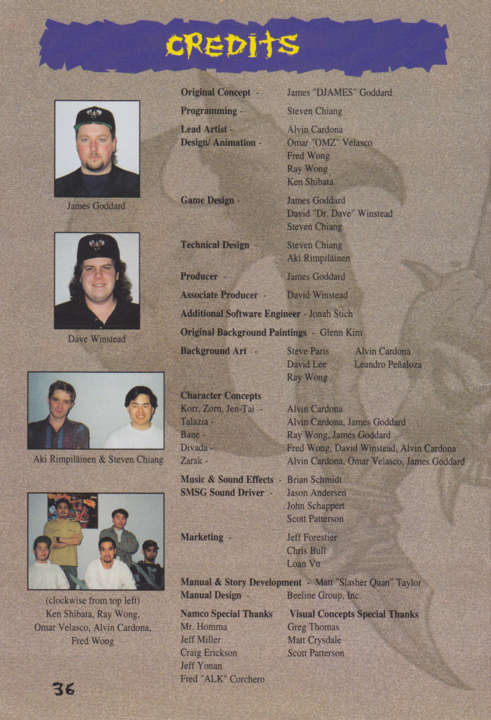On a warm April night in 1995, two developers reclined on their balcony and stared up into the sky. It was three o'clock in the morning, and a hundred stars stared back as the pair swapped stories of heroic barbarians and monstrous demons. These late-night discussions were common for James Goddard and David Winstead. Together with the team at Visual Concepts, they had spent the past 13 months building a game designed to give Street Fighter and Mortal Kombat a run for their money.
That game was WeaponLord.
Since development began, this one-on-one, weapons-based fighting game consumed Goddard and Winstead's lives from dawn to dusk. When they were not in the office, the two game makers were back at the two-bedroom crash pad they shared with game tester Fred Corchero. Armed with crates of Snapple and Easy Cheese, the three alternated between competitive bouts of Street Fighter and endlessly tuning their usurper to the throne. This is the game they always wanted to make, and each is confident WeaponLord will be more badass than anything the fighting game genre has seen before.

Part One: DJAMES and Dr. Dave
Throughout the early 1990's, a lasting divide between Eastern and Western fighting game design was forming. Eastern fighters, such as Street Fighter and The King of Fighters, had a reputation for fast-paced, highly complex play; while Western fighters, such as ClayFighter and Primal Rage, demonstrated a simpler, slower-paced approach. Unless you were Midway, creators of Mortal Kombat, it was suspect to think the West could bottle the technical wizardry of the East. Then along came WeaponLord. Designed by a small team in California, this game sought to combine Eastern complexity and Western brutality into one muscle-bound, broadsword-wielding whole. WeaponLord's creators thought they would conquer the world with this game--but they had to make it first.
"There was no Internet back then," Goddard said, "so if you knew these tricks, such as doing a walking pile drive with Zangief, people thought you were a voodoo priest or something!"
James "DJAMES" Goddard never cheated at Street Fighter, though plenty of people accused him of such. "There was no Internet back then," he said, "so if you knew these tricks, such as doing a walking pile drive with Zangief, people thought you were a voodoo priest or something!" Knowledge was power, and Goddard knew all the tricks. In 1991, he was hired by Capcom, creator of Street Fighter II, as a game tester, and quickly rallied that into an apprenticeship at the company's Japanese offices. He then took that knowledge and worked his way up to support designer and advisor on Street Fighter II: Champion Edition, followed by master game balancer on Street Fighter II: Hyper Fighting. Goddard was learning from the best, and those lessons would help him immensely when developing WeaponLord.
David "Dr. Dave" Winstead was in the right place at the right time. The time was 1989, and the place was Gary's Game Corner, a locally owned comic book and video game rental shop in Redwood City, California. Not far from Gary's, a little magazine called GamePro was just getting off the ground. The editors would sometimes stop by to peruse the games selection, and Winstead was always there to toss in his two cents. Eventually, this made an impression on Patrick Ferrell, one of the magazine's founders, who tasked Winstead with turning his stream of advice into a few demo articles for the magazine. Before long, the young writer found himself taking screen shots part-time, and eventually becoming a full-time editor.
Then Street Fighter II happened. In 1991, Capcom's breakout fighting game landed in American arcades, jump-started arcade culture, and created the template for a new genre of gaming. Unlike most arcade games, Street Fighter didn't have you compete over a high score. It was direct competition against the person standing next to you, and if you lost, it was because the other person was better, plain and simple. Winstead was enamored. "I told the editors this game was crazy! I'd never played anything like it. You really got this buzz off fighting another person." He knew Capcom had struck gaming gold, and he pushed for coverage in the magazine. After some convincing, his editors relented, and suggested he contact Capcom about purchasing a Street Fighter II arcade board. Given the game's popularity, they were sure to have plenty in stock.

Capcom didn't have any in stock. It could barely keep up with orders already because of the game's explosive popularity and didn't have any extras to sell to random magazine editors. But Winstead kept calling, and one day an exasperated Capcom representative handed the phone off to James Goddard. When Goddard learned that he was talking to the Dr. Dave of GamePro magazine, he got an idea. This was a golden opportunity to get arcade coverage in a console magazine. He arranged to get Winstead a board, and in the meantime he invited the writer down to Capcom's offices to check out the latest version of the game. The two hit it off quickly, and within a few days they were meeting regularly to play--and analyze--Street Fighter. They were obsessed.
Roughly a year later, in 1992, Goddard offered Winstead a job working with him at Capcom R&D. The R&D department was currently a one-man operation, and Goddard needed someone who shared his passion for the game and who could help shape its future. Winstead, still early into his career at GamePro, wasn't sure at first, but the other editors encouraged him to follow his dreams and not let this opportunity pass by. After much consideration, Winstead accepted Goddard's offer and Street Fighter became his full-time job. "The work was never done," he said. "We would bring the arcade board with the latest build home, and we'd play religiously three or four hours a night before emailing updated suggestions to Japan."
As the former journalist settled into his new life at Capcom, Goddard was already planning his next move. By 1993, he was becoming frustrated with Capcom's direction for the future of Street Fighter. The 25-year-old developer was ready to try his hand at game design. And Ken Lobb was going to make that happen. Lobb, an employee at Namco, was working on an unannounced project (codenamed "Melee") and encouraged Goddard to join the team. Little did Goddard know this was because Lobb was planning his own move, and when Goddard made the jump, so did Lobb. Melee ended up in Goddard's hands, while Lobb joined Nintendo to develop Killer Instinct.
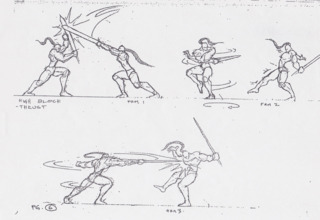
Meanwhile, Winstead remained at Capcom a little longer, helping publish Aliens vs. Predator and other games. But eventually--inevitably--his old friend came calling, and the offer was even more enticing than before. This is our chance, Goddard told him, to finally make a fighting game of our own! This wasn't going to be one of the many copy-cat Street Fighter II clones flooding the market. It was going to have weapons. It was going to be a gritty, "no-bullshit" take on barbarian style. It was going to be their game.
This was an offer Winstead couldn't refuse.
Together again, the duo took stock of their new team. Visual Concepts was known for its work with Electronic Arts on various sports games, including Madden and NHL. Recently, the developer had taken its first, awkward steps into the fighting genre with ClayFighter on the Super Nintendo. Now they were working with Japanese publisher Namco on Melee, a four-player brawler. A handful of Visual Concepts' staff, around 20 people, was assigned to work on the game, and they didn't bat an eye when Goddard proposed taking it in a new direction.
By January of 1994, Melee had been scrapped and development was in full swing for WeaponLord (the project's new codename). However, dark clouds were gathering on the horizon. The golden age of the 16-bit game console was waning, and a new technology--3D technology--was on the rise. Change was coming to the realm of video games, and WeaponLord, an original, 2D fighter developed for home consoles, was looking to become the last of its kind. As an American team supported by a Japanese company, Visual Concepts had been granted the leeway to create exactly what they wanted. It was an envious circumstance that would, for better or worse, forge WeaponLord into a fighting game unlike any other.
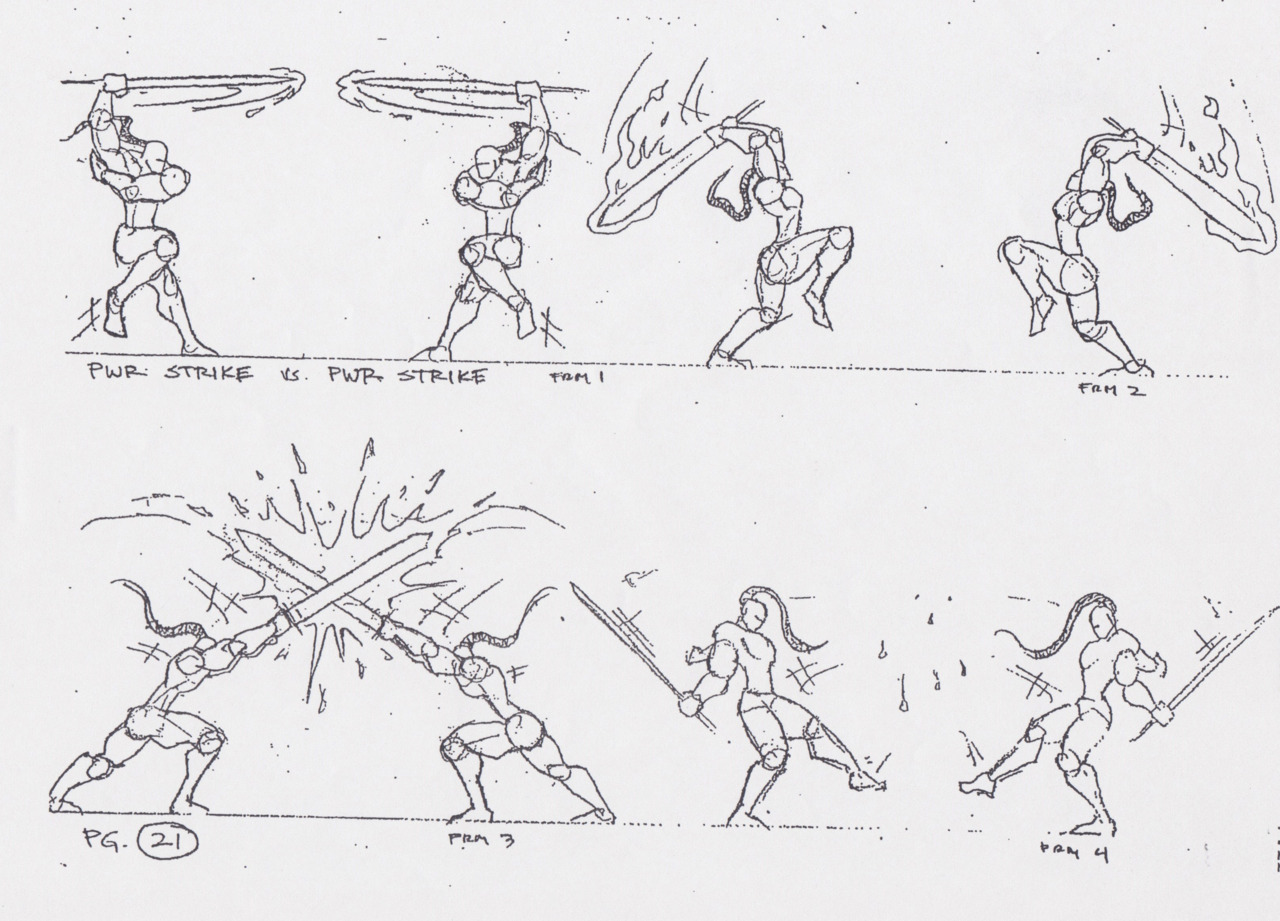
Part Two: Mountain of Skulls
The roar of rock and roll filled James Goddard and David Winstead's small office at Visual Concepts. Sitting shoulder to shoulder, the two fighting-fanatics-turned-game-developers drummed along with the beat as they pored over WeaponLord's latest incarnation. Metallica, Black Sabbath, Judas Priest--these were the game's unofficial soundtrack, and a constant fixture around the office. Around the corner, lead artist Alvin Cardona and his team acted out different attacks using makeshift weapons, while across the hall the two programmers worked tirelessly to compress all this creativity into three tiny megabytes. Development had begun!
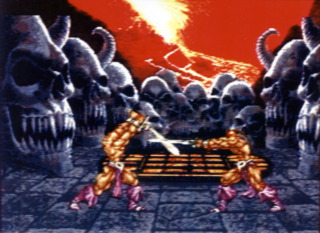
True to its name, WeaponLord's heart was in its weapons. The game was designed to take Street Fighter's fundamentals into uncharted territory. "We were really pushing to keep players at close range," said Winstead, "so we designed the game to make everyone use their weapons as much as possible." Most design sessions between the two developers began with "Wouldn't it be cool if…" and ended with their lead programmer explaining everything that could go wrong. Still, Goddard and Winstead were not deterred, and they continued iterating until they had one of the most complex, and brutal, fighting systems to date. Weapons could collide mid-strike, attacks could be parried and countered, weapons could be broken, and players could strike opponents who were on the ground--these designs were extremely complex for their time, maybe too complex for their own good.
"In the first two weeks after I started on the project we already had a rough skeleton of all the mechanics for the game," said Winstead, "so we were able to start drilling down in the characters right away. Man, I look back on it now and realize, yeah, we really made this game complicated!" WeaponLord demanded precise, calculated play--and gave nothing to button mashers. Victory was never an accident, it was a reward. Goddard and Winstead were confident that seasoned fighting game players would relish the chance to test their skills against this complex game.
Unfortunately, this mentality left a lot of players behind. "All of those systems combined to make an extremely advanced game for 1995," said Goddard. "At the time, my young ego told me, 'Hell yeah, we're designing so many cool mechanics!' but now the 22-year veteran tells me, 'Yeah…that was over design.'" The team wanted to ensure their game wasn't just Street Fighter with swords. So they took every chance they could to put their own spin on genre conventions, such as creating some new command inputs, like holding down a button and then inputting the directions to perform a special move.
"The idea of everything just being a dragon punch or a fireball motion seemed like sacrilege back then," Goddard continued. "Those inputs were just way too common, and it would have felt like ripping off Street Fighter. We wanted to honor Street Fighter by using some original commands--but, of course, the reality is we would have been more accessible if we hadn't. The idea of having to seek knowledge in a fighting game was huge back then, which is part of the reason why WeaponLord was so deep."
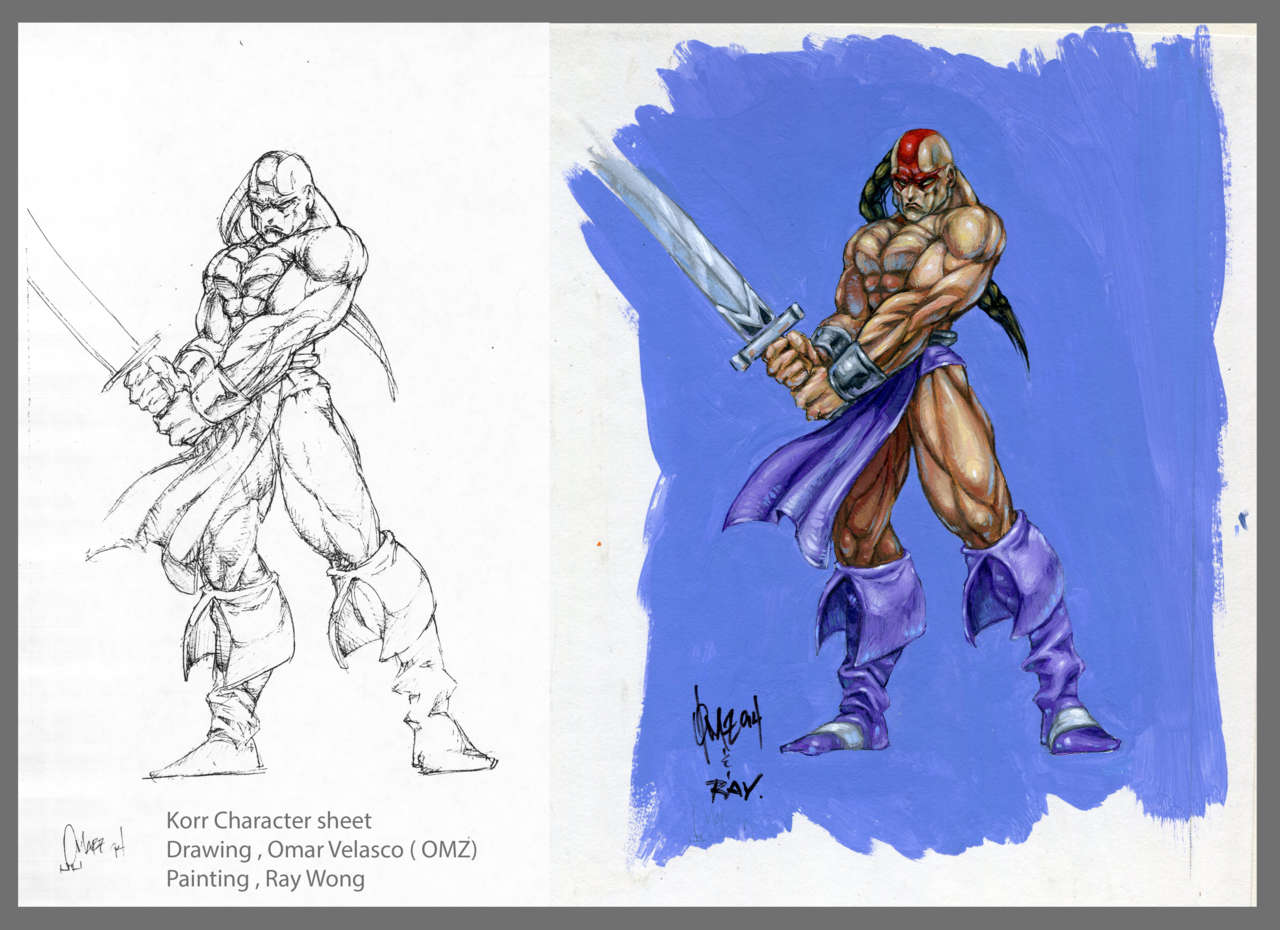
Goddard wanted WeaponLord to have an art style all its own, something different from the anime style of Street Fighter and other Japanese fighting games; something that could match its bloody, over-the-top action. The answer: barbarians. As a lifelong fan of Conan the Barbarian comics, the movie Highlander, and the artwork of Simon Bisley and Frank Frazetta, Goddard wanted to give the cast of WeaponLord a threatening, hyper-muscular look unlike any other. To help him do that, he found a kindred spirit in Visual Concepts' lead artist, the late Alvin Cardona.
Right out of the gate, Cardona's designs were in line with Goddard's testosterone-fueled vision, and his team rallied behind him. "[Cardona] knew where he wanted to go with this game, and helped us get where we needed to go--he was basically the Hannibal to our A-Team," said artist and animator Omar "Omz" Velasco. "He brought us all together to work on this thing, and was a great leader for us. He was genuinely personable, and helped many young dudes get where they are today. I was lucky to have him as my first [boss]."
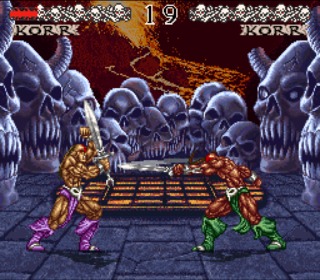
"We were all really excited to be working on a fighting game that pitted barbarian characters against each other wielding awesome killer weapons," added artist and animator Ray Wong. "I remember there was a wall with a ton of sketches pinned to it. [Cardona] used it to show what final drawings were approved, and maybe some work-in-progress stuff as well, for reference on the game's look. This was an awesome sight to see and inspirational. He set the bar high for everybody to follow when doing the art for the game, and we all did whatever it took to make the best game possible."
Together, Cardona and his team worked through character concepts, sprites, and key animations. Due to cartridge size limitations, they knew WeaponLord was going to be light on the number of frames for each attack animation, so they had to make sure each frame they included looked as cool as possible. This lead to some admittedly outlandish poses, but wasn't an issue as long as the game looked badass. And if anyone ever got stuck on a tricky attack, they could always pop in one of the many martial arts movies littering their area for reference. Either that, or pick up the wooden sword and shield and act out attacks personally.
WeaponLord's arenas needed to be just as violent as the warriors themselves. Working remotely, background painter Glenn Kim painted skull-and-spike-filled stages, including the game's iconic mountain of skulls. However, much to Kim's dismay, his impressive paintings were then scanned and converted into 256-color, 8-bit images. "I didn't even know what that meant at the time," admitted Kim. "I remember when they showed me the first converted image, I said, 'That's what it's going to look like?'"
After being scanned, the backgrounds were handed off to Cardona's team, who then cleaned up the images pixel by pixel, added in animations, and separated the layers--all by hand. Thankfully, for the majority of stages they only had to touch up half of the image, which would then be flipped on the other side to make it appear whole. "It must have been a very meticulous, painful process," Kim said. "Had I known all that was going on, I would have kept the details much simpler. But even after the first one, no one said, 'Glenn, you have to dial it back,' so I just went for it all gung ho!" Below is a gallery of Kim's concept art for WeaponLord's backgrounds.
Part Three: Drunk on No Sleep
As WeaponLord's art came together, the designs were then shipped to the game's composer, Brian Schmidt, who worked remotely from Chicago. A Visual Concepts veteran, Schmidt took one look at these threatening images and knew exactly what they needed. "They looked very big and dark and muscular," he said, "so I wanted to give them a sort of heavy rock feel, but with an orchestral feel in the background and a bit of chanting. It honestly didn't take a lot of time to decide on the style of music."
Schmidt would begin a composition in complete silence using pencil and paper. "When I had something I was happy with, I'd go to my midi synthesizer and tweak the piece to match the Super Nintendo's capabilities. In the case of the Genesis, I didn't use midi. I used a text editor I'd written that could interpret these text music files and compile them down into something the Genesis could play." The finished tracks were then sent back to Visual Concepts' HQ and became an instant hit. The heavy drum beats and wailing guitar gave each fight a threatening energy that fit perfectly with WeaponLord's style.
"We mixed the music down a little lower than is typical for a fighting game. That let the music beat deep and heavy without stepping on the sound effects."
But the sound effects weren't fitting. The game's emphasis on weapon clashes demanded that the sounds of metal-on-metal violence be perfect. "The problem is, if you record a sword hitting something else, it actually sounds kind of wimpy," Schmidt said. To find that perfect sound, the composer was forced to try some unexpected combinations. "Some of the final weapon sounds came from a metal nail file hitting a pizza pan--it's all trial and error. You bang two objects together, pitch the sound down, stretch it out, and manipulate it into something that's, well, badass!"
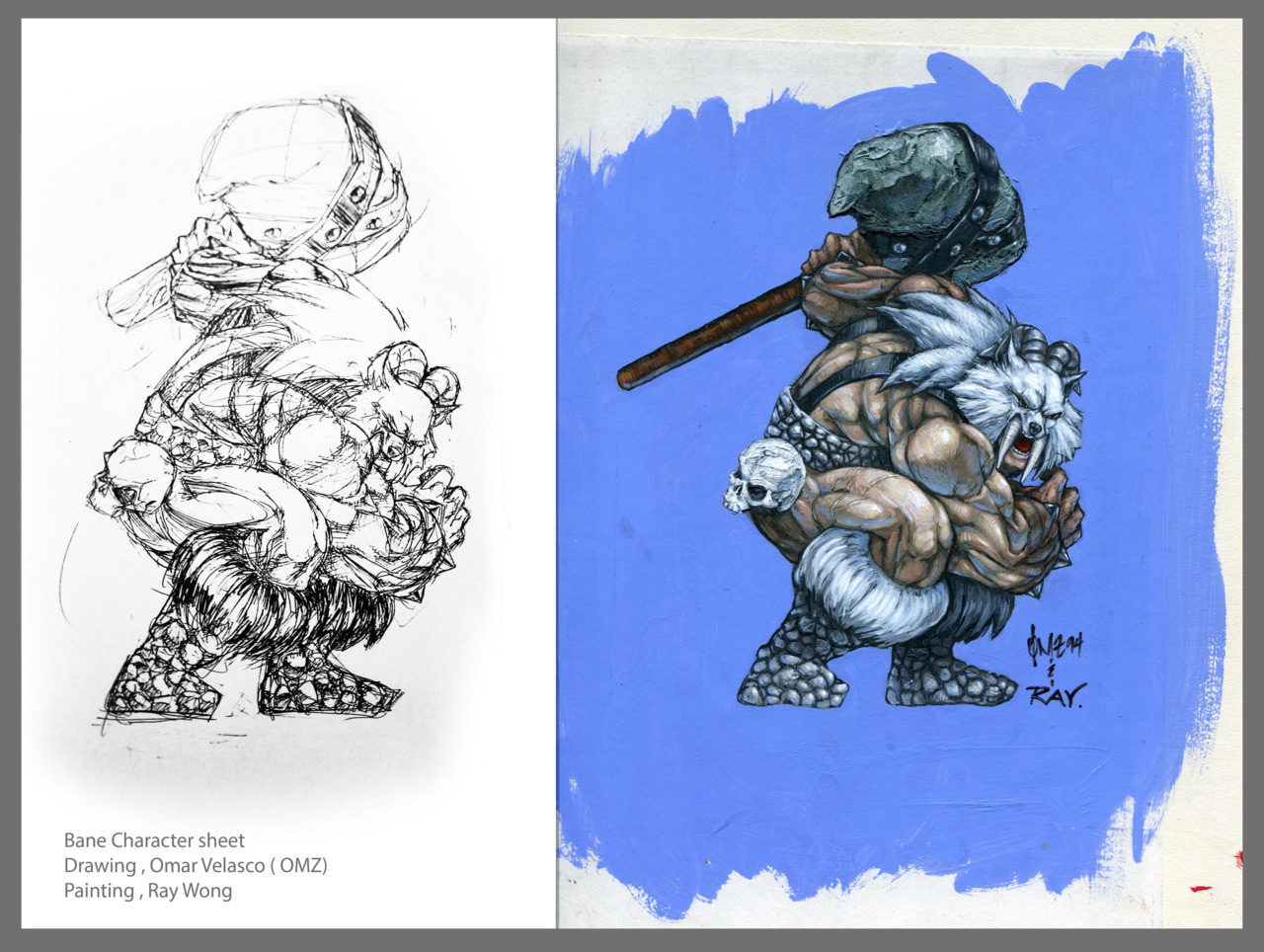
Six months into development, production on WeaponLord was proceeding smoothly. Everything--characters, stages, music--was at a sufficient level of badassness. But there was one lingering problem that kept rearing its ugly head: cartridge size. WeaponLord was being developed for a 24-megabit cartridge--roughly the size of a modern MP3 file--which made compressing a serious challenge. To make matters worse, Goddard wanted huge character sprites that dwarfed the genre's standard, which only compounded the size issue.
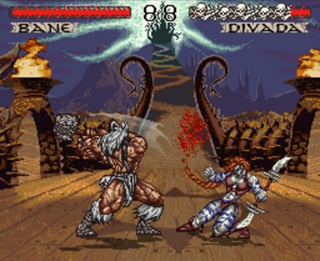
"People always wondered why the characters were so big," Goddard said. "That's because we wanted larger-sized characters to help put the focus on weapon-to-weapon clashing." In order to see the weapons clash onscreen, they needed to be big, which meant they needed to be wielded by even bigger warriors. "It was a technical feat to jump from 90 pixels tall to 120 pixels tall--and still run at 60 frames per second! Later on we realized at 24 megabits we were maxed out on space; we just couldn't add any more characters. That's why our dudes have a ton of moves, to make up for the fact there are only seven characters."
Upgrading to a 32-megabit cartridge was an option, and would have solved a lot of problems, but it was ultimately deemed too expensive to be practical. Visual Concepts had to make do with what it had, which generated no shortage of troubles for the team's two programmers: Steven Chiang and Aki Rimpilainen. Chiang was on staff from the beginning and was intimately familiar with the Super Nintendo's limitations. "The SNES had this sprite draw limit," he explained, "and if you exceeded the number of hardware sprites, they wouldn't draw, leaving 'holes' in the characters. A couple of us built a tool to hand-optimize the sprites within a character, and I'm pretty sure I hand-optimized the sprites in every frame of animation for every character to avoid hardware sprite draw limitations."
In addition to combating hardware limitations, Chiang was helping Goddard and Winstead design WeaponLord's fighting mechanics. "Part of the tool system I had to create was building break points into our animations. So, on the back half of this swing, I'd insert this break point, and if you already had a special command queued up, the game would cut off that swing's animation and go into your other command." The three then worked together to adjust the timing of attacks so players could combo them together, but not too easily. They then had to hand-draw, and redraw, collision rectangles for each attack. "It had to be just right. If you were off a pixel, it could be the difference between being balanced or broken."
"More programmers back then didn't have a formal education--they grew up hacking the ZX Spectrum or Commodore 64 and later on used those skills to make video games," said Rimpilainen.
Rimpilainen joined the team partway through development to bring WeaponLord to the Genesis. "The SNES version looked better overall--it had more colors and better audio capability--but the Sega Genesis hardware had a more modern CPU, which I took advantage of by scaling everything down: audio sample rates, color depth for characters and backgrounds, etc. This made the Genesis version run faster than the SNES version, and I was able to add in some dynamic environments as well as using the extra CPU time."
Having only two full-time programmers on staff might not seem like a lot, but as Rimpilainen explained, that was really all you needed. "Back in the '90s, one or two engineers could handle all the programming for a game. Now it's common to have five to 10 per game. Back then we used assembly language instead of a complied, higher-level language such as C++. Coding in assembly is incredibly tedious, but also rewarding since you know exactly what the CPU is doing. Perhaps partly due to this, more programmers back then didn't have a formal education--they grew up hacking the ZX Spectrum or Commodore 64 and later on used those skills to make video games."

As New Year's Eve came and went, and WeaponLord passed its one-year development mark, spirits were running high at Visual Concepts. The game had a clearly defined vision, and everyone was excited to see it brought to life. During their off-time, Goddard would round up as many co-workers as he could for a monthly pilgrimage to the Sunnyvale Golfland arcade, where they honed their skills in the latest fighting games. One evening they gathered for a very disappointing Highlander: The Final Dimension screening, and later for a very exciting Star Trek: Voyager kickoff party. The hours were long, but also a lot of fun.
For Goddard, long hours meant long nights passed out on the air mattress propped up behind his desk. "There was this rush of building a game with your own hands; it was real exciting and pushed me to just keep going. We were just this young team trying to kick ass and do an awesome barbarian game. In fact, I remember not leaving the office for three days straight--it was that insane! That three-night run was a big turning point: when your boss shows up and then sleeps on the floor alongside you, that is what cements your relationship with the team." After the night was done, Goddard would simply tilt his air mattress back against the wall and go right back to work.
Some nights were crazier than others. "James and I would actually do these late-night karaoke sessions in the office," admitted Winstead. "You know, when you've been working all night and it's three in the morning, sometimes you just go a little cuckoo and need to unwind. James had this three-disc boom box with detachable speakers and a microphone jack in the front, and we used to put on Dio's "Holy Diver" and all kinds of other crazy crap. Of course, we just substituted all the words with our own words since we were basically both drunk on no sleep. It was terrible, and crazy, and fun."
Part Four: Pending Collapse
Jeff Anderson was glad he didn't have to break into WeaponLord's source code--the creators had offered to do it for him. As a game cracker for Catapult Entertainment, it was his job to reverse-engineer Super Nintendo games to make them compatible with the company's online multiplayer service, XBAND. The XBAND modem docked with games similar to a Game Genie, and for a monthly fee, players could compete with people across the country. This was no small technical feat for the team at Catapult.
"Essentially, there were a few small windows in a game's code where you could insert code overlaying what was on the cartridge without the game realizing it," explained Anderson. "For example, when the game would check for the input of the second player's controller, we would intercept that command and route it to the player inputs coming from our modem. We would then have to buffer the inputs from the local player for a few frames to ensure both games coincided with each other."
Goddard and Winstead were already intimately familiar with XBAND, having spent countless hours in online matches back at the crash pad. They knew online play was the future and were willing to tweak their game for its online debut. "Knowing we were going to have a quarter-second lag from New York to California, we realized we couldn't have any startup frames on our thrust blocks," Goddard stated. "We also added cross-up protection by designing a rising thrust block that would counter those attacks easily." Of course, there were other issues the pair couldn't account for. "After a match, anyone could just hit *69 and call you on the phone," Winstead said. "We ended up getting a lot of trash talk that way!"
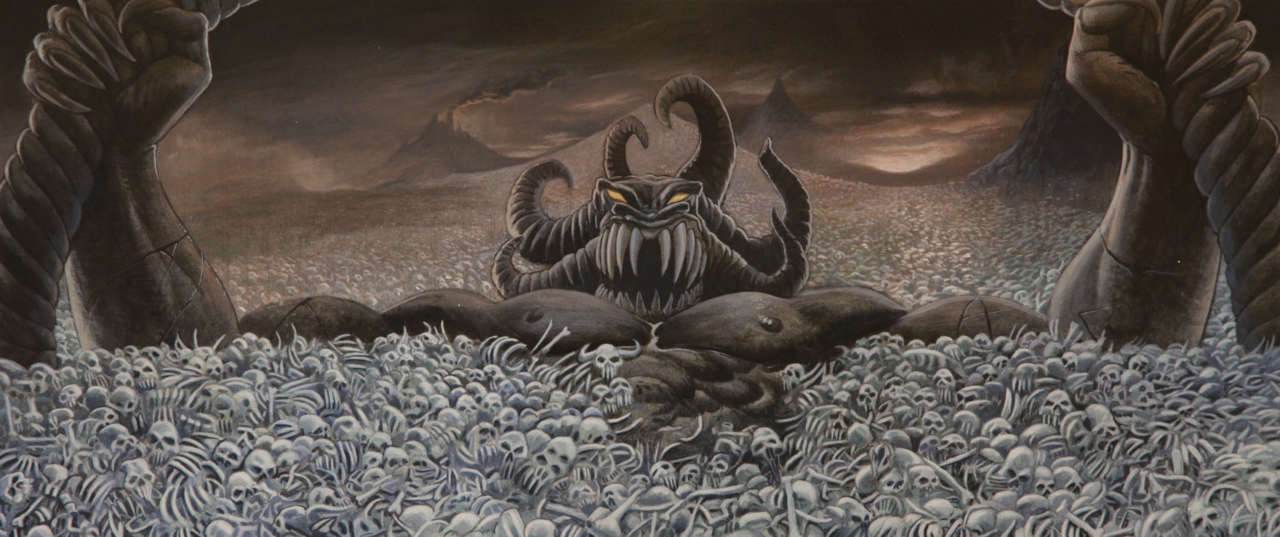
"Struck down by the hand of Korr, the great demon lord Zarak is dead. Bathed in the blood red light of the warrior's moon, the barbarian raises his weapon to the gods. As the power surges through Korr's veins, the voices of a thousand dead heroes chant his name. The battle cry of the weaponlord echoes across the lands… The prophecy has been fulfilled!!"
By April of 1995, Visual Concepts was feeling the pressure. WeaponLord's July release date was fast approaching, and there was still so much to fit into the game--including a story mode. The scene above from Korr's story mode ending perfectly captures the savage tone Goddard and Winstead were striving for. "The story didn't really take shape until the very end," said Goddard. "We were smart about making sure not to take focus away from the core game." WeaponLord's story was split between its two primary modes: arcade mode, which gave insight into a character's past, and story mode, which told what happened after the game ended.

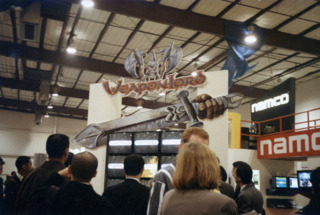
While story mode survived the cut, another critical mode did not: training mode. For a game this complex, the team knew some sort of instruction would be vital in helping new players adjust. Though it never made it past the concept stages, WeaponLord's training mode would have run players through 20 lessons on the game's mechanics--from simple weapon clashes all the way up to its graduating lesson: death combos. However, memory limitations were already getting squeezed as far as they could, and the team was running short on time. Training mode was cut, but the work invested would find a second life in another Namco fighter. For now, however, Visual Concepts had other matters to worry about. A new trade show, the Electronic Entertainment Expo, was coming up, and it sounded like it was going to be pretty rad.
E3 1995 was an electric time in gaming. 3D graphics were the next big thing, and everyone was excited to see where they would take the industry. During Sony's keynote address--in which it announced its PlayStation console--Olaf Olafsson, president of Sony Electronic Publishing, said, "In the 16-bit past, technology suddenly got us closer to achieving [the industry's] creative goals, but not nearly close enough. This is evident by the pending collapse of the 16-bit platforms, which we're all witnessing much faster than anyone anticipated."
"Pending collapse." These were ominous words that hung over the show's 2D attractions, including EarthBound, Castlevania: Dracula X, and Killer Instinct. At Namco's booth, Goddard and Winstead were witnessing this change up close. WeaponLord had an attractive display--including an amazingly awesome/awkward live-action trailer--but was also sharing space with another new Namco fighter: Tekken. Tekken was 3D, it was fast, and anyone could pick it up and start mashing out combos. WeaponLord wore its difficulty on its sleeve, which created some issues when giving quick show-floor demos.
"People would then come up and try to mash away on WeaponLord," said Goddard, "and I would have to stop them and demonstrate how to play. That was the first indication that maybe our game was too hardcore." Goddard and Winstead were working in shifts on the show floor and taking notes on all the feedback they received. This was the game's first public showing, and they wanted to collect as much data as possible. "When they saw the weapon clashing, that's when their eyes lit up, and the death combos as well had people going, 'Holy crap!'"
The two developers returned from E3 with a difficult choice to make. Attendees had consistently stated that WeaponLord was "too slow." Would the team ignore this feedback and move forward on schedule, or take extra time to retune the mechanics? Always one to put fan feedback first, Goddard chose to take an extra month to make changes. "We lessened hit pause as combos progress, speeding them up about 10 percent as you go through a combo, and sped up the game 5 percent overall." With these last-minute adjustments made, the game was ready for manufacture--it was ready to go gold.
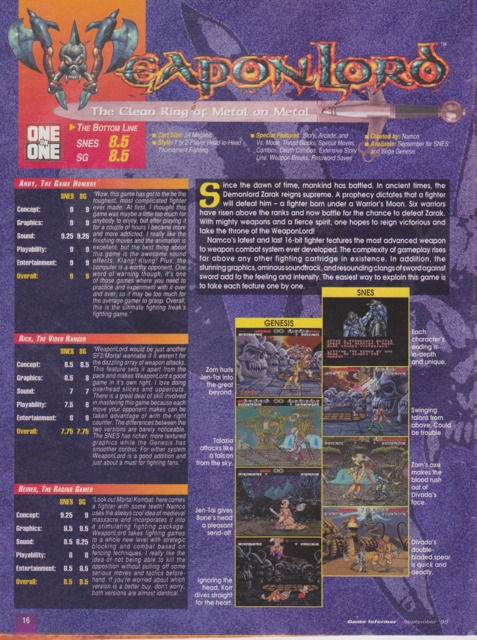
However, that extra month in development ended up costing WeaponLord immensely.

"Back in the '90s, going gold was a big deal," said Schmidt. "You couldn't do a patch or a downloadable update; that was it. The game was burned into ROMs and set forth for all time." And so, after 19 long months of development, WeaponLord was submitted for approval from Nintendo and Sega. The game earned a clean bill of health--no bugs--which raised the team's spirits, but then came the gut punch: Sega was short on 24-bit cartridges. Just like that, Goddard's one month delay ballooned into a three-month nightmare. As the industry raced toward its 3D future, Weaponlord was forced to wait. "Everything just stalled out," Goddard admitted. "After all that time--all that work--the game was just out of our hands."
With nothing left to do for the game, the team at Visual Concepts withdrew for some much-deserved R&R. "We were so beat, we all scattered to our various locations and disappeared off into the blue yonder," said Rimpilainen. "We came back roughly three weeks later wondering if we'd sold any copies." They had, but not nearly what they'd hoped. The three-month delay from August to October of '95 meant WeaponLord was released against Killer Instinct and Sony's revolutionary PlayStation console. The game was supposed to ship 750,000 units to retailers, but after the delay, that number dropped to 200,000 units. It enjoyed (mostly) favorable reviews from the press, but simply got lost in the shuffle.
Despite its devastating impact, the team knew the cartridge shortage alone wasn't to blame for WeaponLord's performance. "I think when we aimed for hardcore, and hit it on the head, that was ultimately WeaponLord's biggest success, and also its biggest downfall," explained test and design apprentice Fred Corchero. "We were too close to the project. Playing it as much as we did and bringing in tournament players to test it heavily influenced the tuning and balancing of the game. WeaponLord was hard because that was the game we wanted to play. It was too hardcore for mainstream players. That was a hard lesson to learn as a designer, but I'm glad I learned it early in my career."
"That was the fun of it, in a way, because none of us really knew what we were doing," Kim added. "We were just doing what we thought was cool. There were no hard-and-fast rules on how to make a fighting game--or any video game. We didn't have all this data. It was just, 'This is what we want to make. I don't care. Let's do it!' That was the attitude back then, and it was my attitude as an illustrator."

In the tightly knit community of fighting games, each game has an impact. Some make a big splash that quickly fizzles out, while others--like WeaponLord--cause a tiny ripple that carries out for miles. Visual Concepts didn't conquer the world with this game, but it certainly made a lasting impression. Years later, Winstead repurposed the game's scrapped training mode for Tekken 2. And it's hard to deny that the guard impacts and parries from Soul Edge and Street Fighter III, respectively, bear a striking resemblance to this game's hit-deflecting thrust blocks.
But what's most impressive is that today--nearly 20 years later--WeaponLord still enjoys a cult following in forum posts within the fighting game community and across the Internet, a fact that makes the developers extremely proud. "A few years back I was working at a company that had a gladiator game in the works, and 'leaked' a really blurry image to see how it would resonate with players," said Corchero. "We were following the thread at work, and someone mentioned 'Weaponlord 2' as a guess. The thread turned into a plea for WeaponLord 2. It was very bittersweet to see that there were people that wanted it, but knowing that it wasn't the answer to our blurry picture."
Perhaps, one day, the warrior's moon will come out again.
"Korr returns to his people, the Tarok. His days of wandering and fighting in the combat arenas are over. With his great victory, Korr's soul is finally at ease. He can now prepare to assume leadership of the tribe. Only one thing in life troubles Korr. There is still no word of his twin brother, Kang. One day, they will meet again. Korr prays it will not be in battle."
This article is dedicated to the memory of Alvin Cardona. Thanks again to all the WeaponLord team members who let me harass them with questions over and over, including game tester Ben Cureton whose interview I didn't have space to use. In addition, if you're curious why there has never been a WeaponLord 2, I spoke with the team about that as well.
